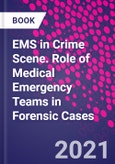EMS in Crime Scene: Role of Medical Emergency Teams in Forensic Cases addresses the different settings that occur in pre-hospital environments, along with the medical-forensic relevance surrounding evidence preservation. The book identifies the main difficulties in this subject to promote proper intervention. The main role of EMS will always be medical assistance, but it is also their job to ensure their safety, the safety of the victim and the protection of the local scene. This means of preserving evidence, even though it is an ancillary activity and is not meant to compromise care of the victim, is an important role of EMS.
The objective of preserving where a crime has occurred is, from the outset, to keep the environment as unchanged as possible, that is, not to move and/or subtract objects from their original position (even if it is a firearm) and not to add elements that were not present at the scene, such as shoe trail marks, earth, hair strands, cigarette butts, etc.
Please Note: This is an On Demand product, delivery may take up to 11 working days after payment has been received.
Table of Contents
1. Emergency and urgency: concepts and evolution2. Criminal investigation historical aspects3. Physiopathology of death4. Violent death5. Violent death in emergency department and prehospital6. Evidences with medical-legal relevance7. Crime scene8. Criminal investigation9. Intervention protocols10. Intervention in the preservation and collection of evidences11. Forensic artifacts12. 911 call center13. Documentation in forensic cases14. Intra- and extra-hospital material for preservation and collection of evidences15. Final considerations








